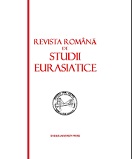PREZENTE PONTICE SI EGEENE ÎN DESCOPERIRILE MONETARE DE LA ALBESTI (JUD. CONSTANTA)
PONTIC AND AEGEAN PRESENCES IN THE COIN DISCOVERIES FROM ALBESTI (CONSTANTA COUNTY)
Author(s): Maria Bărbulescu, Livia BuzoianuSubject(s): History
Published by: Ovidius University Press
Keywords: coins; the autonomous period; Callatis; Histria; Macedonia; the Roman Empire
Summary/Abstract: The article presents the coin discoveries in the fortified settlement from Albesti, having for a long time the attention of the specialists-archaeologists and historians. The samples under debate are able to offer chronological and economical (trade) hints for this settlement. There are presented 56 samples-40 from the autonomous period and 16 from the Roman period ; there is also known the archaeological context for 21 of them. The autonomous period coins are coming from the Callatian mints (15) and from Histria (4). Two silver Callatian samples are to be especially mentioned for their importance (among which a drachma dated between the middle of the 4th century and 313 B.C.). The other Callatian coins are made of bronze and are to be dated in the 3rd century B.C. The discovery of some of them on the South side line of the 3rd precincts (A sector) represents for us an argument to date the building. There are three silver drachmas from Histria to be dated in the 4th century B.C. (possibly the beginning of the 3rd century B.C.) and a bronze coin. The foreign coins are represented by three samples issued by Aegina ( 4th century B.C.), the Tauric Chersoneus (the end of the 4th century-the beginning of the 3rd century B.C.) and Odessus (the end of the 3rd century-the beginning of the 2nd century B.C.) There are 14 coins from Macedonia and belong to Phillip II (9 samples), Alexander III (4) and Phillip II Arrhidaeus (1). The samples with the name of Phillip II belong to the coast geographical area, otherwise well represented, generally for the Macedonian coins. Other two coins from the autonmous period belong to the Thracian king Amatokos II (359-351 B.C.) and the the Scythian king Sariakes (probably the 2nd century B.C.). From the chronological point of view, the period between the middle of the 4th century-the beginning/or the first decades of the 3rd century B.C. is the best represented. The Roman coins are represented by a Republican denar dated in 137 B.C., 14 imperial coins and a Byzantine follis. There are 6 coins belonging to Constantinus II and they possibly indicate a temporary inhabitance here in the first half of the 4th century A.D.
Journal: Revista Română de Studii Eurasiatice
- Issue Year: 7/2011
- Issue No: 1+2
- Page Range: 27-44
- Page Count: 18
- Language: Romanian

